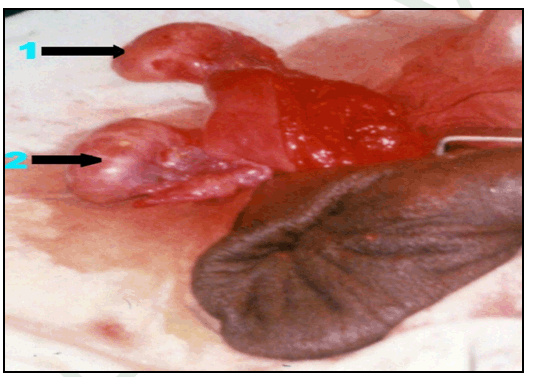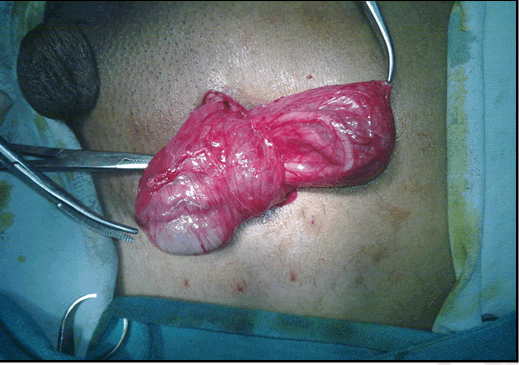  |

|
 |
|
Case Series
| ||||||
| Transverse testicular ectopia in adults: A case series | ||||||
| Divish Devendrakumar Saxena1, Murtaza Akhtar2, Mrinal Tandon3 | ||||||
|
1MS, FMAS, FIAGES, Assistant Professor, Department of Surgery, NKP Salve Institute of Medical Sciences, Digdoh Hills, Nagpur, India.
2MS, FMAS, Professor & Head, Department of Surgery, NKP Salve Institute of Medical Sciences, Digdoh Hills, Nagpur, India. 3MS, Senior Resident, Department of Surgery, NKP Salve Institute of Medical Sciences, Digdoh Hills, Nagpur, India. | ||||||
| ||||||
|
[HTML Abstract]
[PDF Full Text]
[Print This Article]
[Similar article in Pumed] [Similar article in Google Scholar] 
|
| How to cite this article |
| Saxena DD, Akhtar M, Tandon M. Transverse testicular ectopia in adults: A case series. Int J Case Rep Images 2015;6(8):465–468. |
|
Abstract
|
|
Introduction:
Transverse testicular ectopia (TTE) or transverse aberrant testicular maldescent is a rare clinical entity where both testes descend into one side of scrotum. The patients having TTE often present with ipsilateral inguinal hernia associated with migrated ectopic testis and contralateral empty hemiscrotum and non- palpable testis.
Case Series: We are reporting two cases of a rare testicular descent anomaly where both patients presented with unilateral inguinal hernia with contralateral non-palpable testis and were diagnosed as transverse testicular ectopia intraoperatively. On examination, two separate cords were found to be coming out from same inguinal canal. There were no cord anomalies or remnant of Mullerian duct. In both of the cases inguinal hernia repair with orchiopexy was done. Conclusion: In a patient with unilateral inguinal hernia and contralateral absent testis, a strong suspicion of TTE should be kept and ultrasonography or MRI scan should be carried out in such patients for the location of testis. However the treatment is hernia repair with an attempt to place the testicles in their respective hemiscrotum. | |
|
Keywords:
Crossed Ectopia, Transverse testicular ectopia, Undescended testis, Urogenital anomalies
| |
|
Introduction
| ||||||
|
Transverse testicular ectopia (TTE) also termed as unilateral double testis, false duplication of testis or transverse aberrant testicular maldescent is a rare clinical entity where both testes descend into one side of scrotum [1]. Cryptorchid testes have two anatomical variants. In first variant the testis stops at some point during its normal descent and is termed undescended testis which might be in abdominal or inguinal or in prepubic region. In the second variant, the testicular descend is more dramatic where the descent of testis is in its normal course up to the inguinal canal and then the course of descend changes aberrantly after crossing the superficial inguinal ring. This variation of testicular descend is termed ectopic testis. The ectopic testis can be found in the superficial inguinal pouch, perineum, medial aspect of thigh, femoral triangle and penile region or in the contralateral hemiscrotum [2]. The patients having TTE often present with ipsilateral inguinal hernia associated with migrated ectopic testis and contralateral empty hemiscrotum and non-palpable testis. | ||||||
|
Case Series
| ||||||
|
Case 1: A 30-year-old married tribal infertile male presented with right groin swelling since 10 years with empty left hemiscrotum. On exploration both the testis were found to be in right inguinal canal. Both the cords were coming out from the right internal ring with hernia sac between the two cords (Figure 1). Sac was isolated; herniotomy was done followed by mesh hernioplasty. Left cord was mobilized but due to inadequate length of the cord the testis was placed in the right scrotum. Testicular biopsy from both testes showed testicular tissue with partial atrophy. Semen analysis was not done due to lack of facilities. Case 2: A 28-year-old unmarried male presented with left groin swelling since one year with non-palpable right sided testis since birth. On groin examination, the left testis was palpable with left indirect inguinal hernia and empty and undeveloped right hemiscrotum. Ultrasonography revealed absent right testis while scrotum showed normal left testis with left inguinal hernia. Exploration of left inguinal canal revealed right testis in close approximation with left hernia sac and left testis anatomically located. Both the testes were normal in size and consistency. The right testis with its spermatic cord was transferred to the right hemiscrotum and orchiopexy was done in subdartos pouch (Figure 2). | ||||||
| ||||||
|
| ||||||
| ||||||
|
Discussion
| ||||||
|
Transverse testicular ectopia is a clinical entity where one testis migrates to the contralateral side giving a false impression of testicular duplication. Till now more than 100 cases of TTE have been reported in literature [3] [4]. Lenhossek [5] was the first clinician to describe this anomaly when he was performing an autopsy with his father. Similar description was given by Jordan [6] who reported transverse testicular ectopia in an eight year old boy while operating for left inguinal hernia. In 1907, Halstead [7] was the first surgeon to publish this unique case in literature. Various theories have been postulated to describe the etiological factors responsible for transverse testicular ectopia. In 1960, Gupta et al. [8] suggested that during embryological life, early fusion and adhesion of the Wolffian ducts leads to adherence of one testes to other, thereby the contralateral testis follows the path of ipsilateral testis during its descend. But this theory was opposed by Gray et al. [9] who opined that since in majority of cases the ducts are separate, the crossing over must have occurred later in life. According to another theory proposed by Kimura [10], both the testis must have originated from the same genital ridge and the true crossing would have taken place only when a separate ductus deference reach each testis. TTE have been classified into three groups [11] depending upon the presence of other genitourinary anomalies:
The diagnosis of TTE is often made intraoperatively in a patient with unilateral groin swelling with empty contralateral hemiscrotum as was reported in both the cases. In the first case, no investigations were available as the patient was operated at a remote tribal area during a surgical camp and in other case in spite of basic imaging, the condition was missed by radiologist may be due to lack of awareness and commonality of hernias as diagnosis. Strong preoperative suspicion should have led us to do MRI scan for localization of testis as MRI scan is an important investigative tool in diagnosis of undescended testis [12] [13]. Along with pelvic and inguinal ultrasound, diagnostic laparoscopy could be another tool of investigation [13] [14]. The theories of origin, clinical presentation are well understood, but the treatment guidelines are lacking. A two staged procedure to bring the ectopic testis into its correct inguinoscrotal region have been also described. The recommended procedure, when the ectopic testis is found at superficial inguinal ring or in the inguinal canal is its separation from the hernia sac and ipsilateral cord structures, followed by its transfer to the contralateral hemiscrotum with orchiopexy. | ||||||
|
Conclusion
| ||||||
|
Inguinal hernia presenting on one side with absence of testis on the other side, a strong suspicion of transverse testicular ectopia (TTE) should be kept and ultrasound or magnetic resonance imaging scan should be carried out in such patients for the localization of testis. However, the treatment is hernia repair with an attempt to place the testicles in their own hemiscrotum. | ||||||
|
References
| ||||||
| ||||||
|
[HTML Abstract]
[PDF Full Text]
|
|
Author Contributions:
Divish Devendrakumar Saxena – Substantial contributions to conception and design, Acquisition of data, Analysis and interpretation of data, Drafting the article, Revising it critically for important intellectual content, Final approval of the version to be published Murtaza Akhtar – Analysis and interpretation of data, Drafting the article, Revising it critically for important intellectual content, Final approval of the version to be published Mrinal Tandon – Analysis and interpretation of data, Drafting the article, Revising it critically for important intellectual content, Final approval of the version to be published |
|
Guarantor of submission
The corresponding author is the guarantor of submission. |
|
Source of support
None |
|
Conflict of interest
Authors declare no conflict of interest. |
|
Copyright
© 2015 Divish Devendrakumar Saxena et al. This article is distributed under the terms of Creative Commons Attribution License which permits unrestricted use, distribution and reproduction in any medium provided the original author(s) and original publisher are properly credited. Please see the copyright policy on the journal website for more information. |
|
|





